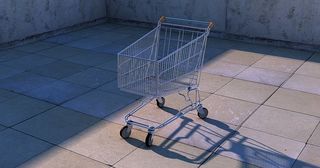Aging
Getting Older? 14 Ways to Bounce Back from Aging Challenges
Ideas to help you stay optimistic when you are raging against aging.
Posted September 4, 2019 Reviewed by Lybi Ma

The Case of the Disappearing Groceries
The other day I was at the supermarket, happily putting some of my favorite goodies into my cart. But as I wheeled toward the cashier, items began mysteriously disappearing. I looked around to catch the thief in the act but saw no one. By the time I got to the check-out line, every single item I had chosen had vanished. My cart was now empty.
I was livid. I stormed at the clerk: “What kind of a place is this? All of my groceries have disappeared! Every single thing is gone!”
I was so furious that I woke myself up.
The Challenges of Aging
Sometimes the unconscious mind really nails it. Yes, what kind of place is this? This year, as I approached yet another landmark birthday, I had been assailed by numerous minor chronic illnesses and conditions—death by a thousand cuts, as I described it to myself. One of these conditions, an intractable six-month-long case of heel pain (plantar fasciitis), was causing me to hurt literally with every step, preventing me from moving about with ease and from engaging in my favorite exercise—walking.
But while the unconscious mind may have a direct pipeline to one’s current emotional life, it lacks perspective. It was not true that all the good things in my life were vanishing one at a time, and that all that remained was to “check out.” My physical ailments were annoying, painful, and inconvenient, but none were life-threatening. I had every reason to believe that the heel pain might go into remission at some point. Most importantly, I had an abundance of blessings in my life—a wonderful partner and family, interesting work, friends, and numerous small pleasures.
Still, the dream reflected a certain kind of truth—that I was now facing the realities of aging. It was not a pleasant truth. At times I felt stabs of depression and despair. I realized I needed to find a more hopeful perspective, one that could keep me optimistic, stop the needless catastrophizing, and help me cope with my “new normal.”
14 Ways to Bounce Back from Aging Challenges
I began experimenting with a variety of strategies, some science-backed, some idiosyncratic. I’d like to emphasize that while these strategies worked for me in varying degrees, everyone is different. Still, my hope is that anyone in a similar situation to mine could adapt these strategies to their own aging or health challenges, at whatever age they might be. Here is what I learned and re-learned:
- First and foremost, give yourself the gift of self-compassion. Self-compassion will prevent you from adding self-criticism to your burden of suffering. For example, because my problems are small in comparison to those with more serious health conditions, I tend to discount them. I’ve even caught my critical inner voice labeling myself a “wimp.” This is not helpful! Pain hurts, even if the pain of another may be greater. If “self-compassion” seems like an abstract idea to you, try this mantra from author Kristan Neff’s book Self-Compassion: “This is a moment of suffering. Suffering is part of life. May I be kind to me in this moment. May I give myself the compassion I need.” For quick access to this wisdom, memorize it.
- Look your best. Some people would condemn such advice as shallow or vain. But vanity can be a great motivator for healthy change. And looking good can raise morale and self-esteem. "When you put in the effort to improve your appearance, you find that your opinion of yourself becomes more positive," says mental health counselor Fred Silverstone, writing for older men here. Of course, his comment applies just as well to women.
- Pace yourself. This essential insight comes from PT blogger Toni Bernhard, who has created a plethora of helpful books and blogs on coping with chronic pain. Many of her insights apply also to aging. One of her helpful suggestions is the 50 percent rule: Decide what you can comfortably do, and then do just 50 percent of it. (More tips here.) I would add: Prioritize what matters most. Have the courage to be imperfect. Set the bar lower.
- Accept that both despair and joy will be part of the aging journey. The losses of aging do take their toll. But surprisingly, research has documented that there is a steady rise in happiness among people over 50, despite problems of illness and aging. That’s because older adults know these truths, in the words of author and therapist Mary Pipher: “Many of us have learned that happiness is a skill and a choice. We don’t need to look at our horoscopes to know how our day will go. We know how to create a good day.”
- Approach the moment with a wholehearted attitude. Cultivate the habit of opening up to the present moment and appreciating it. Even difficult moments can be savored. Mary Pipher again: “As we walk out of a friend’s funeral, we can smell wood smoke in the air and taste snowflakes on our tongues.”
- Reframe your problems as challenges. This simple technique can immediately reduce stress and set your inner creative problem-solver into motion.
- Make time your friend. I’ve learned that the passage of time—even five minutes—may change your pain level and even how you feel about your life in general. In this way, it resembles what we say about the weather in my hometown: “You don’t like the weather? Just wait a minute.” The ancient wisdom of “This, too, shall pass” still applies.
- Find a level of exercise that works for you. A boatload of research tells us this: No amount of exercise, however small, is ever wasted. Whether in the form of standing up and stretching, household chores, or formal exercise, studies demonstrate numerous physical and mental health benefits of exercise, even in small bits. (Ideas for "exercise snacks" here.) Since I'm an exercise cheerleader, it is ironic that I have not been able to exercise in my usual way, and that is why I recommend that you:
- Find replacements for any activities you must curtail or stop. While afflicted with heel pain, I’ve had to stop walking. But I've discovered that I can use a stationary bike or work out with weights while standing in place on a thick yoga mat.
- Connect with others, even in small ways. It’s not surprising that friends and family can be extremely helpful in lifting your spirits, but I’ve learned that acquaintances and even relative strangers can also be good companions on your journey. For example, I’ve gotten to know a variety of people at my physical therapy center. Chatting with them always gives me a lift and helps the time on that stationary bike go by more quickly. Because of my own experiences, I was interested to read recent research indicating that brief interactions with strangers can give you a mood boost. This research, as summed up here, "suggests that a happy life is made up of a high frequency of positive events, and even small positive experiences make a difference."
- Find a “purpose project.” Research strongly indicates the value of a sense of purpose for older adults. Benefits include better health and longevity, among others. Your purpose can be as personal as taking care of grandchildren or as complex as social justice or a community goal. (See “The Purposeful Life is Healthy and Wise” by Susan Krauss Whitbourne.)
- Treat yourself to a treat or two, or three. Given that small positive experiences make for a happier life, as discussed above in #10, figure out how to include more of those experiences in your day. That's where treats come in. Treats do not necessarily have to be food treats. They can be exercise "snacks," cultural events, TV shows, books, fun conversations, and other small pleasures.
- Appreciate your age and the life that you've experienced. When you think about it, it's really amazing to be on Planet Earth and to live a life here. Think of your age as an accomplishment, not as a liability.
- Find G.O.D. Although I’m not religious, I find that having a spiritual orientation can be invaluable. In my case, I realized that I needed to focus on G.O.D. G.O.D. is my personal shorthand for “Gratitude Over Despair.” Physical and psychological pain makes it harder to be grateful. In the face of health troubles, I had to approach gratitude with deliberate intention, actively focusing on cultivating the “gratitude attitude.”
In addition to this list, I’m sure you know to practice these common-sense actions: Eat right, get plenty of sleep, laugh a lot, and practice self-care. See a therapist if you feel depressed or call the Suicide Hotline (800-273-8255) if need be.

Refilling the Cart
In a way, I’ve been lucky that I've had to cope with a swarm of small problems rather than face one or more huge, devastating ones. My experience has been like a vaccination that may better prepare me when the bigger and stronger “viruses” come along. Hopefully my "coping immune system" has been activated.
Since I don't think anyone can live well with an empty cart, I see this list of 14 items as a way to lay in new supplies. I intend to pay particular attention to the idea of creating as many small positive experiences as I can in my day.
What items do you need for your cart?
© Meg Selig, 2019. Please contact me for permissions.
References
Harvard Men's Health Watch, “Regain Your Confidence,” June 2019, Harvard Health Publishing.
Pipher, M., “The Joy of Being a Woman in Her 70s.” New York Times, 1/12/2019.
Neff, K. Self-Compassion (2011). NY: HarperCollins.
Bernhard, T. Pacing: The Chronically Ill Person's Best Friend. Psychologytoday.com, June 15, 2016.
Nicolaus, P. "Want to Feel Happier Today? Try Talking to a Stranger." NPR, July 26, 2019.


